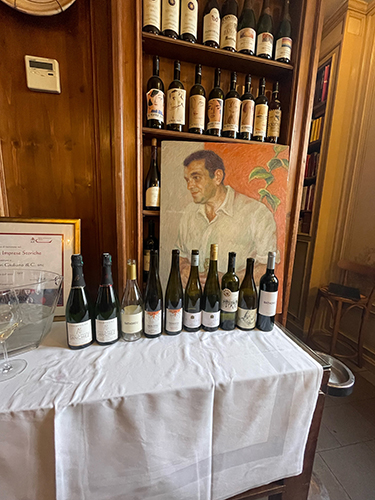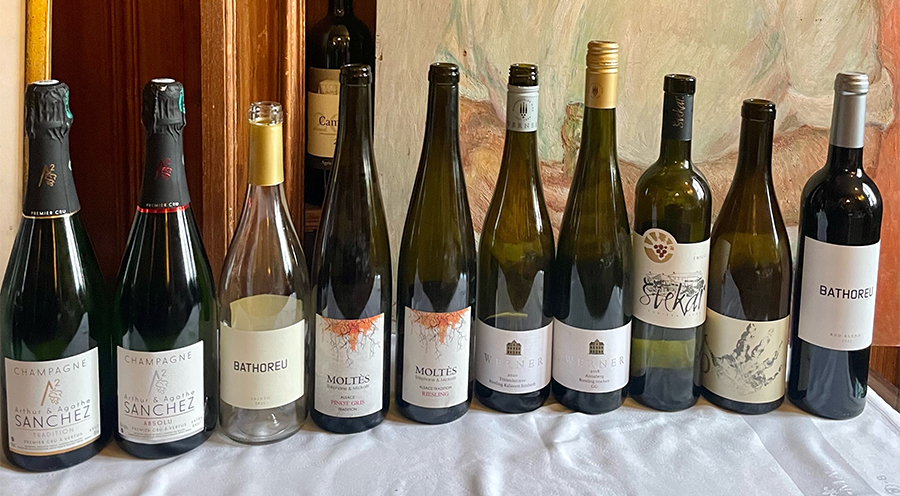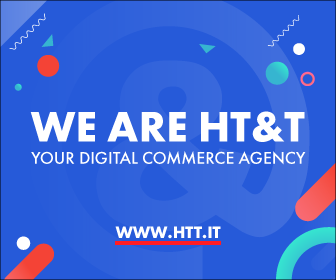The opportunity to taste something uncommon and/or brand new is always welcome by the wine lover. What a pleasure then the invitation from the distribution Wines.com for the presentation of its selection of foreign (quite rare) wines, in restaurant Da Burde in Florence last November 30th.
We have started with two Champagnes from the maison Arthur & Agathe Sanchez (yes, I can agree with You that champagne tastings are not that uncommon, but do You think we bothered?). It is a relatively big maison owning several tenths of hectares of vineyards: part of the crop is sold to big brands, and only the best selection of the grapes is home vinified.
 We have tasted 2 cuvées: the Brut Tradition (when we feel depressed, we can think about how many Brut Tradition we have had in our lives!), 60% Chardonnay, 40% Pinot Noir, 8 gr/lt of residual sugar, enjoyable resonance of fruit in mouth, good volume at the sip, but mousse slightly aggressive with feeling of sweetness overwhelming the salted depth.
We have tasted 2 cuvées: the Brut Tradition (when we feel depressed, we can think about how many Brut Tradition we have had in our lives!), 60% Chardonnay, 40% Pinot Noir, 8 gr/lt of residual sugar, enjoyable resonance of fruit in mouth, good volume at the sip, but mousse slightly aggressive with feeling of sweetness overwhelming the salted depth.
And a much better (to me) Blanc de Blancs Pas Dosé Absolu (THIS is a singular choice), obviously 100% Chardonnay, with a superior texture (here the aging on the lees arrives to 4 years minimum), and a sip played on the interaction between saltiness and acidity: a tastier and more persistent wine over all.
Then we have skipped to the first still proposal of the day, a white Arinto from the Portuguese estate of Bathoreu. Arinto is a lusitan variety known per its flamboyant aromatic expression, but seldom blended with something fresher to grant it some more acidity. That means that probably I hadn’t ever tasted a straight Arinto before (here we go!). The nose was enchanting in its tropical fruits expression but the aromatic layout was slightly lost at the sip (but not too much). It was smooth, with just the amount of acidity to make it easily drinkable. The fruity feeling started once again from the “center of the mouth” on candy cedar hints.
Two Alsatian whites have followed, from Domaine Moltès, another family estate dating back to the ‘30s, well known to the owner of Wines.com because of personal connections. We have enjoyed a Pinot Gris 2020 slightly astringent because of a probable minimum maceration of the skins, juicy and mineral, adequately persistent and at the very end better in mouth than at the nose. And an even better Riesling 2020 with (already) a pleasant evolution at the smell, hydrocarbonic notes over a carpet of tropical fruits, with a nice correspondence between nose and mouth aftertaste hints, not to count a nice progression. Very good indeed.
Other two Riesling to follow, but from Mosel region of Germany. Documents regarding the Werner family dates back to 1650, and such a tradition has led to a viticulture very respectful of the environment of the vineyards, and a classic work in the cellar (fermentation in barrel with natural yeasts).
The first Riesling was in the Feinherb style, that means off dry, with flavors limited to ripe lemon peel and an herbaceous hint, a medium intensity, and the idea of lacking a little bit the freshness expected by such a wine. Much better the Annaberg Trocken GG 2018 (a special cru), hard and pure in its mineral depth, still closed by the aromatic point of view but very well balanced, with an interesting future in front.
 The next two wines have been the most controversial of the tastings because of their orange style, almost brought to the extreme consequences, from the Stekar estate of Goriska Brda (the Slovenian equivalent of the Collio region in the Italian Friuli). In the 11 has of the farm owned by his family since 1700, Jure Stekar has been certified organic in 2006. His aim is to fully express the features of the grapes in its territory, with careful work in the vineyard and a reduced intervention in the cellar (no filtration or fining, no sulphites).
The next two wines have been the most controversial of the tastings because of their orange style, almost brought to the extreme consequences, from the Stekar estate of Goriska Brda (the Slovenian equivalent of the Collio region in the Italian Friuli). In the 11 has of the farm owned by his family since 1700, Jure Stekar has been certified organic in 2006. His aim is to fully express the features of the grapes in its territory, with careful work in the vineyard and a reduced intervention in the cellar (no filtration or fining, no sulphites).
The first example of this style was the Sauvignon Gris (Tocai) Emilio 2021: not a long maceration but anyway slightly tannic, with hints of cider and (at least in this moment) a perceivable bitterness at the end of the aftertaste. The Rebula (Ribolla Gialla) Filip 2018 was a bit overwhelmed by the oak used for the aging, that in this moment seems to compress the fruit (only a bit of candy orange peel).
The tasting has ended in a completely different “style context” with the only red proposed, a fifty-fifty blend of the Portoguese star varieties Touriga Nacional and Touriga Franca, again from Barthomeu estate, located along the Tao river, on hills quite far from the ocean.
A kind of entry level red, vintage 2021, aged in steel, that everyone has enjoyed. It was possible to perceive the varietal features of both the grapes, the “flower power”, the black fruit and the spiciness of the first, the overripe hint of the second. In mouth, the delicate tannin of the T. Nacional matched well with the volume of the T. Franca. Balance was granted by a well integrated acidity, fruitiness was neat, the sip practically irresistible.
Thanks to Wines.com for the invitation and the opportunity, and my compliments for choices that anyway have never been banal and show the effort and the commitment behind them, made of repeated tastings on line during the lockdown period and long and deep contact with the producers.
The courses of Da Burde have created an interesting contrast with the features of the wines: not everyone has agreed about all the matchings of food and wine, but they have anyway focused the attention on samples characteristics that deserved to be discussed.
Riccardo Margheri

























